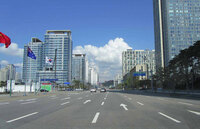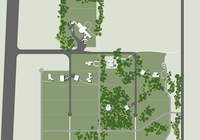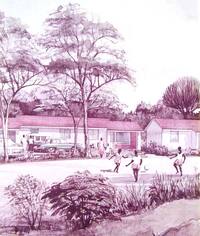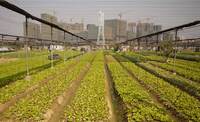Tema Manhean
Article by Michelle Provoost
In 1952, a year after Kwame Nkrumah became the first Prime Minister of what was then the British colony of the Gold Coast (now Ghana), the decision was made to build a brandnew harbour as part of the ambitious Volta River Project. [1] For the relocation of Tema, a small fishing village that stood in the way of the new development, the English office of Maxwell Fry, Jane Drew and Denys Lasdun was engaged.
When Smart Cities are Stupid
article by Rachel Keeton
A few years ago, when ‘smart cities’ starting dominating the landscape of urban trends, it seemed like a pretty exciting model. Technology integrated into every aspect of daily life! A more convenient, comfortable urban experience for everyone! Right?
Chinese urbanization through the lens of Da Lang
Article by Linda Vlassenrood
Shenzhen is a city that has been raising eyebrows for years, because of its fast development and exceptional position. However, the everyday reality in Shenzhen can be unruly. As a city, Shenzhen mainly thinks in top-down strategies and simply adds new hardware – the sum of infrastructure, buildings and industries – in order to encourage urban and therefore economic growth. It is less interested in the question of which existing social dynamics need to be accepted or improved in order to strengthen the city’s potential, let alone the socio-economic conditions that are necessary to (...)
Making Housing Affordable in Fast-Growing Chinese Cities: A Shenzhen Perspective
article by Haotian Lin
Like many other Chinese cities, Shenzhen is experiencing intense spatial transformation. Downgraded neighborhoods are replaced with luxury housing, shopping malls and offices. Such development might improve the competitiveness of the city, but ignores the affordability of the city for lower-income groups. The reliance on the market parties to develop affordable housing has not produced satisfying results. The ‘old’ Danwei housing, which is profusely present throughout the city, has a number of qualities that make it attractive for redevelopment. Might it solve the shortage of affordable (...)
The Dream of a Lifestyle: Master-Planned Communities and the New Tools of Exclusion
’New Towns & Politics’
article by Tobias Armborst, Daniel D’Oca, Georgeen Theodore [INTERBORO]
In the Bill Clinton-endorsed book The Big Sort: Why the Clustering of Like-Minded America Is Tearing Us Apart, Bill Bishop warns that while America is diverse, “the places where we live are becoming increasingly crowded with people who live, think, and vote as we do,” and that “our country has become so polarized, so ideologically inbred, that people don’t know and can’t understand those who live just a few miles away.” [2] Similarly, Gerald Frug, in Citymaking: Building Communities without Building Walls, writes that “the overall impact of American urban policy in the twentieth century (...)
article by Tobias Armborst, Daniel D’Oca, Georgeen Theodore [INTERBORO]
The Politics of Planning: From Social Engineering to the Engineering of Consent Scenarios for Almere, Markerwaard, and New Netherlands 2050 (1965-1985)
’New Towns & Politics’
article by Christian Salewski
article by Christian Salewski
The burden of being planned. How African cities can learn from experiments of the past: New Town Dodoma, Tanzania
’New Towns on the Cold War Frontier’
article by Sophie van Ginneken
Throughout history, the transformation of African cities has always attracted large master plans. Sometimes they are unsustainable. The capital of Tanzania, Dodoma, is an obvious example. Conceptualized as an African city, inspired by Maoist ideals, designed by Canadians and Americans, built by Europeans and Asians, paid for by many, and soon to be re-built by South Koreans - this hidden place has been flooded with global interest and disappointing plans.
article by Sophie van Ginneken
Exporting New Towns. The Welfare City in Africa
Article by Michelle Provoost
Looking at the cities that were built from scratch during the fifties and sixties all over the world, it is astonishing to see how uniform the world population growth was spatially accommodated in places extremely remote and different in culture and political background. The roots of this phenomenon can easily be traced back to the New Towns around London from the forties. Starting in the UK, these New Towns soon became the panacea for urban growth in Western Europe. The new cities around Stockholm, towns like Hoogvliet in the Netherlands and the Villes Nouvelles around Paris: all these (...)
Transformation of Cape Town’s Informal Settlements: “The Pressure Cooker on the Boil”
article by Merve Bedir
The apartheid regime in South Africa maintained its rule through the ‘organization of urban space into racially segregated living areas’ [4]. Since the regime’s fall [1990], the easing of migration rules to cities have lead to the rapid growth of informal settlements in South Africa’s major cities: In 2010, the total population of informal settlements was 9 times more than in 1994 [5]. Whether the migration to cities and the resulting land occupations in post-apartheid era actually undermined the apartheid city or emphasized it, is one major question: Poverty among the ethnically (...)
Farming Chinese New Towns. Rethinking the roles of the agricultural landscape in new town development in China
article by Jiayao Liu
This short read provides a brief review of my graduation thesis: Farming Guangming: Articulating agricultural landscape and new town development for the “Green City” Guangming in Shenzhen. My thesis questions the current urban development and planning practices when dealing with agriculture in metropolitan areas, and argues that being an indispensable part of the urban system, the agricultural landscape should be incorporated in the urban development and planning system to achieve integrated city regions, especially in rapidly urbanizing regions with a long agricultural tradition like (...)












